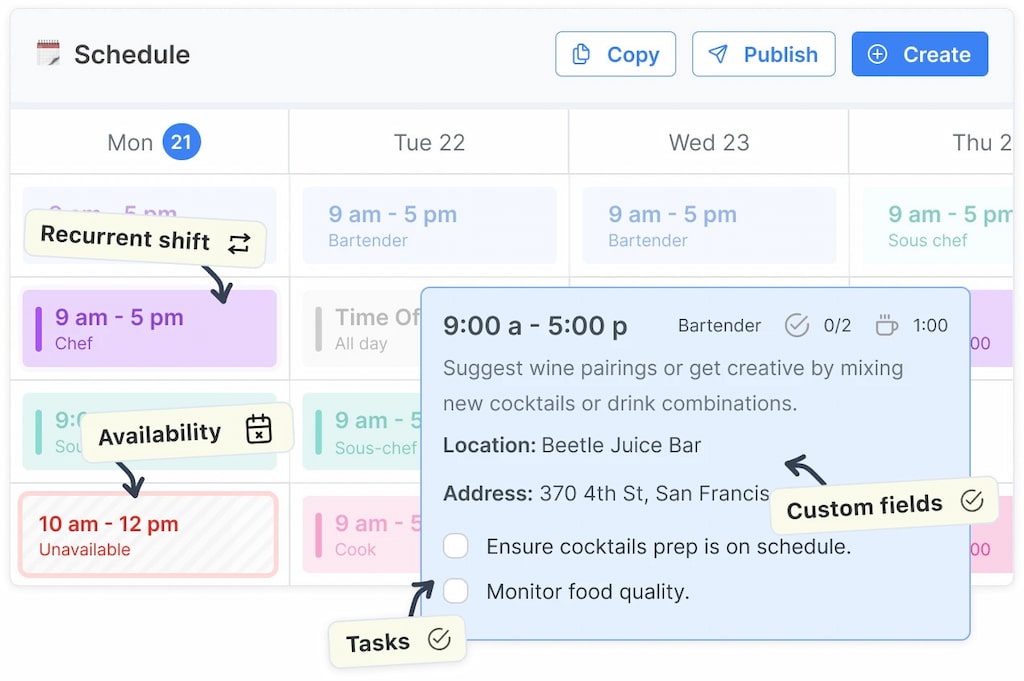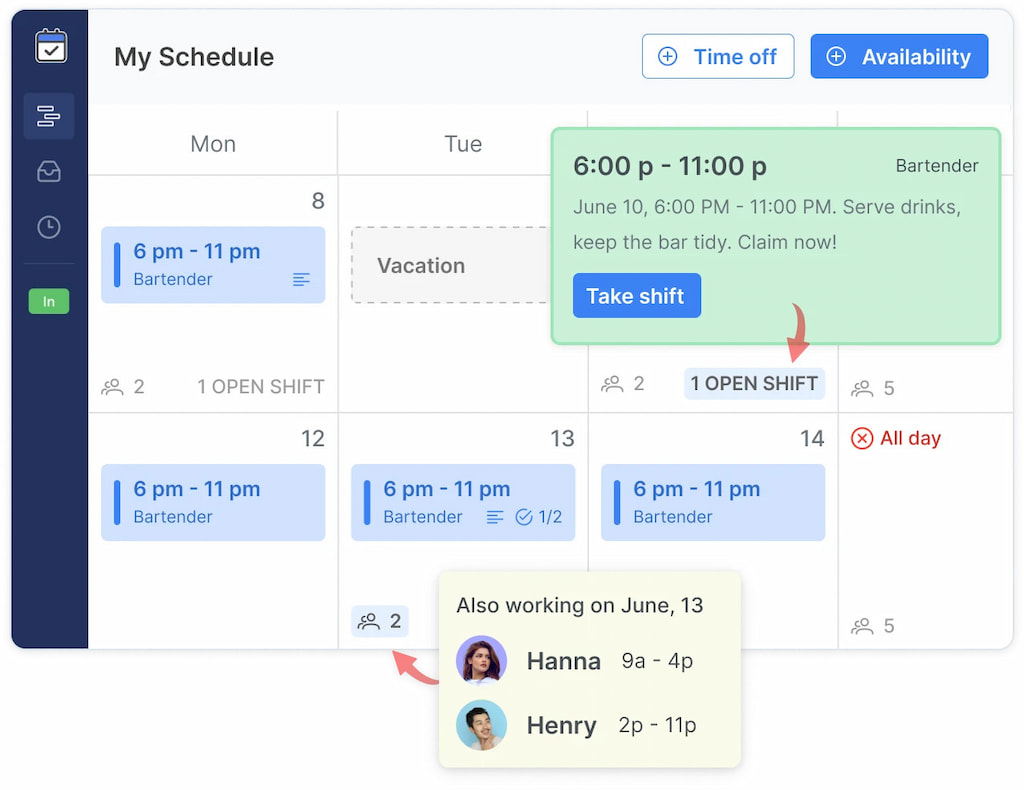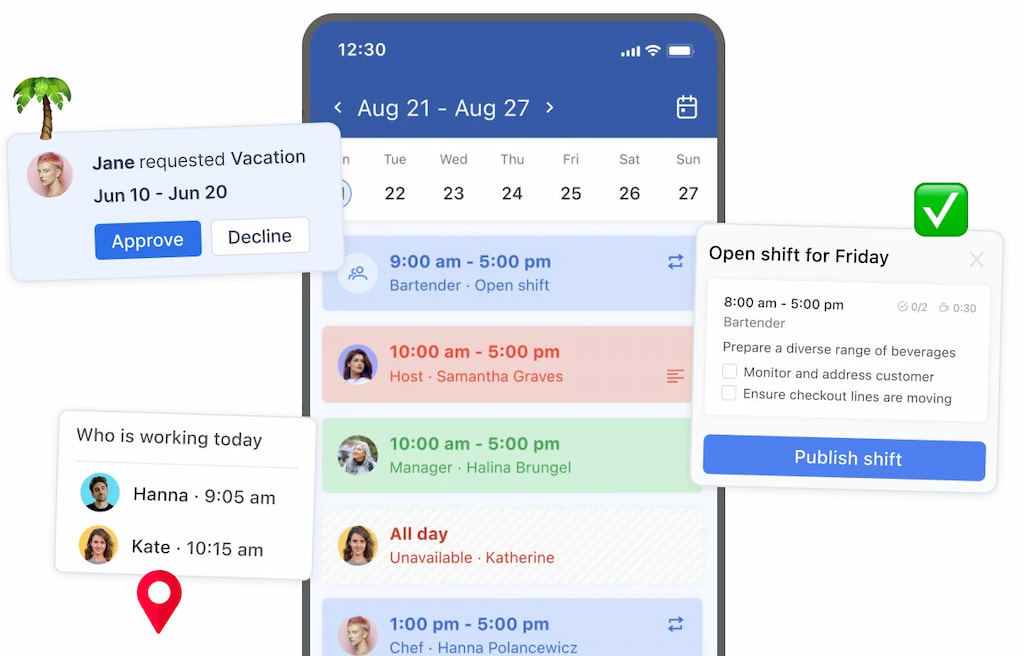You arrive Monday morning to dozens of Slack messages: “I’m double-booked,” “I didn’t see my shift,” “Can I swap?” Meanwhile, your printed roster has scribbles and sticky notes across it. This scene is all too common in organizations that rely on spreadsheets, emails, and assumptions for scheduling.
In 2025, that chaos is preventable. In this article, you’ll discover the most frequent scheduling problems and scheduling conflicts, real-world solutions that scale, and how tools like Shifts by Everhour (or integrated with Everhour) help you turn guesswork into predictability.
🧠 What Is Meant by “Scheduling Problems”?
⚙️ Scheduling problems occur when planning, assigning, or executing work shifts fails to keep operations smooth, employees satisfied, and costs controlled. Common issues include overlapping shifts, staffing gaps, unfair hour distribution, last-minute changes, and burnout.

🌍 In 2025’s flexible and hybrid work environment, these problems carry greater consequences — from unhappy employees and missed SLAs to unexpected overtime and hidden inefficiencies. Solving them isn’t just an operational fix — it’s a strategic advantage.
🔎Common Scheduling Problems & Their Consequences
⚠️ Shift conflicts and overlaps
When two or more employees are accidentally assigned to the same slot, one area becomes overstaffed while another goes understaffed — a frequent issue in manual systems.
Solution: Use auto-conflict detection to prevent overlaps before publishing.
🔄 Unpredictability & constant changes
Last-minute client calls, early departures, or sudden emergencies can disrupt everything if your scheduling system isn’t adaptable.
Solution: Enable real-time rescheduling, buffer shifts, and open shift pickup options.
🚫 Lack of flexibility
Rigid schedules ignore employee preferences and constraints, causing dissatisfaction, absenteeism, and turnover.
Solution: Allow staff to set availability, trade shifts, and request swaps within rules.
⏰ Inadequate notice
Publishing schedules at the last minute prevents workers from planning transportation, childcare, or rest.
Solution: Aim to publish schedules at least a week in advance.
👥 Understaffing or overstaffing
Without accurate forecasting, you risk assigning too few or too many people for the workload.
Solution: Leverage historical data and predictive models to forecast demand and optimize staffing.
💸 Excessive overtime & cost overruns
If total hours aren’t tracked, employees can exceed legal or contract limits, driving up labor costs.
Solution: Implement real-time tracking of scheduled vs actual hours with automated overtime alerts.
📢 Poor communication
When schedules are sent via PDFs or email, staff often miss updates and critical changes.
Solution: Use mobile scheduling apps with push notifications and real-time updates.
⚖️ No transparency or fairness
Perceived favoritism in shift assignment lowers morale and trust among employees.
Solution: Rotate shifts evenly, maintain transparent visibility, and enable fair shift trading.
🤔 Tools That Help Solve Scheduling Problems
| Tool | Key Features | Pricing/Plan | Ideal For |
| Shifts by Everhour | Drag-and-drop scheduling; real-time updates; open shifts & swaps; scheduled vs actual tracking; mobile alerts | Free & paid plans | Teams wanting scheduling and time data in one unified app |
| Connecteam | Scheduling; job workflows; mobile time clock; chat & announcements | Free & paid plans | Field or mobile teams needing an all-in-one ops hub |
| Deputy | Auto-fill schedules; compliance alerts; time clock; shift swapping | Paid plans | Organizations with complex shifts and regulatory needs |
| When I Work | Employee schedule builder; availability setting; notifications; team chat | Free trial & paid plans | SMBs needing lightweight roster control |
| Homebase | Scheduling; time clock; payroll sync; mobile updates | Free & paid plans | Restaurants, cafés, and service operations |
| Sling | Shift templates; labor cost tracking; messaging; rule enforcement | Free & paid plans | Teams moving off manual rosters to digital workflows |
| ZoomShift | Staff scheduling; attendance tracking; shift reminders; payroll export | Free & paid plans | Small teams needing structured shift management |
| Shiftboard | Demand-driven staffing; automation; compliance; analytics | Enterprise licensing | Large operations needing deep scheduling automation |
| Clockify | Time tracking; scheduling; notifications; reporting | Free & paid plans | Small teams combining time and schedule tracking |
Tool highlights & use cases
- Shifts by Everhour: Best for truly reducing “double-work” between scheduling and time tracking.
- Connecteam: Strong mobile experience with communication and workflow modules.
- Deputy: Powerful for compliance-heavy environments with shift rules.
- When I Work: Simple, effective for smaller teams needing basic scheduling and alerts.
- Homebase: Ideal for service industries that need payroll and scheduling tied together.
- Sling: Excellent for teams transitioning away from spreadsheets.
- ZoomShift: Reliable option when you need scheduling + attendance in one view.
- Shiftboard: Suitable for enterprises with sophisticated staffing demands.
- Clockify: Useful if time tracking is your primary need and scheduling is secondary.
🔨 How Shifts by Everhour Solves Scheduling Problems
When dealing with scheduling problems, the tool you use has to be more than a planner — it must enforce rules, offer visibility, and adapt in real time. That’s where Shifts by Everhour becomes a difference-maker.
- Conflict prevention built in: When building rosters, Shifts detects overlapping assignments and warns you or blocks publishing.

- Scheduled vs Actual tracking: By integrating scheduling and time tracking, you can spot consistent deviations and adjust templates or buffer times.
- Open shifts & swap workflows: Staff can claim unfilled slots or swap amongst themselves under manager approval — reducing admin burden.

- Smart overtime alerts: The system notifies you when someone is close to exceeding allowed hours.
- Mobile-first updates: When a change happens, everyone sees it instantly — no outdated PDFs or sticky notes.

- Balanced rotation & fairness: Shifts can enforce rules so that weekends, holidays, or premium hours rotate evenly across staff.
In short, it helps you fix many of the problems above by embedding solutions into the schedule itself, rather than expecting managers to catch everything manually.
💡Best Practices & Actionable Tips
Use these field-tested strategies to reduce scheduling pain:
- 🧭 Collect accurate availability & preferences – Ensure each employee’s schedule fits their real availability.
- 📅 Publish schedules early – Aim to post them at least 7 days in advance.
- 🧩 Reuse shift templates – Save and replicate recurring patterns for efficiency.
- 🧍♂️ Keep a backup staff pool – Maintain swing or reserve workers for last-minute changes.
- ⏱️ Add buffer time – Include short breaks between shifts to handle travel or delays.
- 🤖 Automate swaps & approvals – Minimize manual coordination through automation.
- 📊 Track adherence metrics – Watch late check-ins, overages, and similar indicators.
- 🔁 Review forecasts weekly – Reassess resource needs regularly to maintain balance.
❓ FAQ: Scheduling Problems & Solutions
What’s the most common scheduling problem?
Overlaps and double bookings often top the list, especially in manual systems. Many tools now warn you live before conflicts publish.
How far ahead should schedules be published?
7–10 days gives staff time to plan, arrange childcare, transit, or personal obligations.
Can employees swap shifts safely?
Yes — with guardrails. Use tools that let staff request or approve swaps while enforcing limits on hours, rest time, or roles.
How do I avoid overtime surprises?
Track scheduled vs actual in real time. Tools like Shifts by Everhour alert you when someone is near overtime thresholds.
What if last-minute changes always happen?
Have backup staff or “floater” shifts. Use mobile scheduling to reassign quickly. Make it easy for staff to self-claim open shifts.
⚡ Conclusion: Scheduling Problems and Solutions
Scheduling challenges—like double booking, missed appointments, breaking labor rules, unfair shifts, poor communication, and lack of visibility—can actually become opportunities to improve morale, stay compliant, and work more efficiently.
Modern scheduling software keeps calendars in one place, sends automatic reminders, enforces labor rules, balances workloads, tracks hours, and gives real-time insights. This makes operations smoother and lets managers focus on their teams and clients.
Shifts by Everhour combines scheduling, time tracking, and communication in one tool. If you’re still juggling spreadsheets and last-minute calls, it’s time to see how Shifts can simplify scheduling for your crews.
▶ Find out the difference between staffing and scheduling in our guide!
▶ Streamline work-life balance with the 4-10 schedule — see how it works today!

